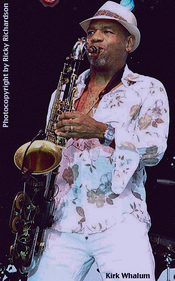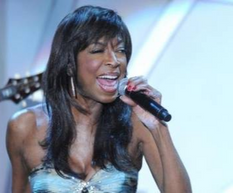10. Keys for Major Scales
We may start on any note for a Major Scale, but still keep the same sound pattern. Here's how:

michael mcdonald
Scales are named according to their starting letter. So the C Major Scale starts on the letter or note of C:
Notice there are no sharps or flats.
Next, the G Major Scale:
Here, from F# to G is a half step, because it has to fit within our Major Scale step pattern (the steps between notes):
Also, E to F# is a whole step (E-F-F#).
Both of these Major Scales (C and G Major) have the exact same step pattern, and SOUND the same overall. Let's compare Major Scales and their sharps: (Remember that B to C, and E to F, have no step between them - Bake Cakes, Eat Food).
- C D E F G A B C
- G A B C D E F# G
- D E F# G A B C# D
- A B C# D E F# G# A
- E F# G# A B C# D# E
- B C# D# E F# G# A# B
- F# G# A# B C# D# E# F#
- C# D# E# F# G# A# B# C#
Don't be afraid of all those sharps (they won't puncture us). As we proceed through each scale, we sharp an extra note.
- C Major has no sharps (0#)
- G Major has 1 sharp (F#)
- D Major has 2sharps (F#, C#)
- Then, A Major has 3sharps (F#, C#, G#)
and so it goes until we add 7 sharps:
F# C# G# D# A# E# B#
(This is not the F# scale from before.) This is a pattern, or order, of sharps we'll use later to make scales.
Conversely, we may compare Flats and their scales, successively adding flats. Starting on 'F', here is the F Major Scale:
Adding only Bb. Let's compare this flat scale to others, starting on different first notes (roots):
- F G A Bb C D E F
- Bb C D Eb F G A Bb
- Eb F G Ab Bb C D Eb
- Ab Bb C Db Eb F G Ab
- Db Eb F Gb Ab Bb C Db
- Gb Ab Bb Cb Db Eb F Gb
- Cb Db Eb Fb Gb Ab Bb Cb
Here, doing the same thing as sharp scales, we add 1 more Flat per scale (remember a scale's first and last notes are the same root note, just 8 steps apart, like F to F).
- F Major Scale has 1 flat (Bb)
- Bb Major Scale has 2 flats (Bb, Eb)
- Eb Major Scale has 3b's (Bb, Eb, Ab)
Continue until 7b's are added:
Bb Eb Ab Db Gb Cb Fb
This is the order of Flats we'll use later to make scales. Remember Major scales follow a step pattern (whole, whole, half, whole, whole, whole, half). To find the number of sharps or flats in a scale, use:
Order of Sharps: (#) F C G D A E B
Order of Flats: (b) B E A D G C F
Use the Step Pattern: WWHWWWH to make a Major scale:
- Start on any letter
- Follow the step pattern, WWHWWWH between the notes
- Land on the sharp, flat, or natural notes to name them
- The last note is the same as the first.
Example:
- A
- AwBwC#hDwEwF#wG#hA
- A-A
Each Major scale sounds alike overall because of this step pattern. Below is a faster way to form a Major scale.
11. Now We Have the Keys!

A Major Scale has a certain number of sharps or flats that make up the Key. We may have seen the 'Key Signature' at the very beginning of a piece of music, with the sharps or flats together on the staff.
Musicians play together with different instruments, so everyone must play in the same Key, as the instruments vary widely in sound range. Each musician must have a reference point for their own instruments' range.

kirk whalum
Further, remembering the Major Scales that added sharps or flats, the sharp# Major Scales add sharps in this order:
The flatb Major Scales add flats in this order:
Both flats and sharps must remain in this order, to quickly name a song's Key (time to concentrate):
Sharps
Use the above Major Scales to add the proper number of Sharps. We'll start with the D scale:
(F#C#) are the 2 sharps in this D Major scale. From the Order of the Sharps, (FCGDAEB), find these two sharps. Take the last sharp, (C#), and raise it a Half Step, to 'D'. The Name of the Key becomes 'D Major'.
We raised the last sharp a half step to find the Key's Name. How did we know it was the last sharp? The Order of the Sharps helped us to count.
Likewise, for the A Major Scale,
we have 3 sharps (F# C# G#). These are the first 3 sharps in the Order of Sharps (FCGDAEB).
From this, raise the last sharp (G#), a half step, and our Key becomes 'A Major'. Arrange the sharps in this order before finding the last sharp.
"If they understood the song's Key, the written music would be only a reminder to play a note sharp, flat, or natural."
Furthermore, when playing with other people and different instruments, each person will sharp the same notes (F C and G), since all are in the Key of A Major. This is true while playing a scale, or any melody.
By not sharping these notes, we'll be playing 1/2 step below the correct note, and we will be out of Key. We'll sound very bad every time we play an F, C, or G natural.
Again, the D Major Scale added two sharps, (F# C#). These happen to be in the correct order of sharps, so we can take the last sharp, C#, raise it a Half Step, and arriving at D, the name of our Key becomes D Major (or DMaj).
Flats
Things are different for flats. Use the above Major Scales to add the proper number of Flats in our scale. Order the flats correctly (BEADGCF), then take the second to last flat, and that is the name of our Key. This is very different from sharps, and easily confused with the method for finding Sharp's Key:
The Bb Major Scale contains 2 flats (Bb Eb). The 'second to last flat' in the order of flats (BEAD-GCF), is Bb. Bb Major becomes the Key's Name. Please remember to stop counting the order at the last flat, (BE...). Take the note before the last one counted, and that's the Name of our Key (for flats).
Everyone playing together in Bb Major Key will flat both notes (Bb Eb). If someone plays B or E naturally, without flatting any note, they will be playing 1/2 step above the correct note. And they will sound horrible every time they play that natural note.

natalie cole
Some beginning musicians have no idea in what Key they are playing. We may hear some wrong notes in a beginners' band, orchestra, etc. They are failing to flat or sharp some notes in the song's Key.
Likewise, beginners may take literally what is written on the sheet music, and make note errors from what they read. After all, the notes are playing a melody, not just a scale. If they understood the song's Key, the written music would be only a reminder to play a note sharp, flat, or natural.
Therefore, keep the song's Key in mind while playing. We'll also teach our fingers or voice correct Key positions. When we don't have to think about sharps or flats, we can focus on art!
Sharp/Flat Rule page that really helps!
The next page does the reverse, and uses only the key's name to find a scale's sharps and flats. Octaves and Triads also are introduced.